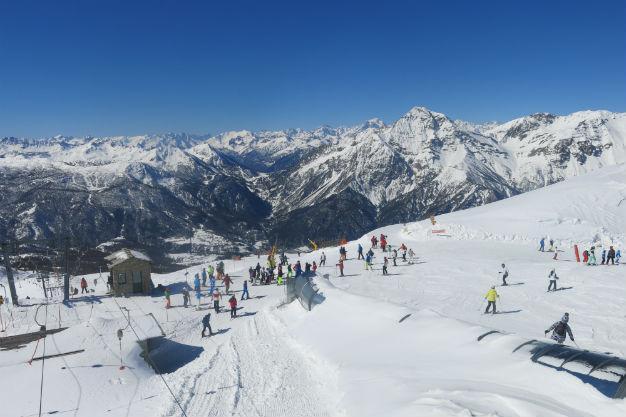Olympic Dilemma
Aylin Öney Tan - aylinoneytan@yahoo.com

“10 anni di noi, 10 anni con voi!”
“Ten years of us, ten years with you!”
This phrase was written proudly on a huge sign in front of Sestriere’s Olympic Village, or Villaggio Olimpico, as it is called in Italian. The Torino Winter Olympics in 2006 was a phenomenon of a decade ago, and in 2016 its aftershocks are still felt. Guido Bolatto, the secretary general of the Torino Chamber of Commerce, simply put it as an economic revolution.
We are at a press conference in Sestriere, Torino, on the occasion of the 63rd winter meeting of the Ski Club International des Journalistes (SCIJ), trying to figure out the post-Olympics situation here. It seems that after 10 years the Olympics is still creating money in Vialattea, or the Milky Way, referring to the white slopes extending along the valley. The benefit is affective for all the Olympic Valleys Communities, namely Torre Pellice, Pinerolo, Pragelato, Sestriere, Sauze d’Oulx, Clavière, Cesana - San Sicario and Bardonecchia.
Olympic Games, in general, are scrutinized for their sustainability and impact on local communities. The sustainability of Olympic constructions has become a big question in the last few decades. Recent practices have shown the games have become all about mega-constructions, unsustainable for post-Olympic use. The future of structures and facilities usually remains unplanned, and the cities hosting the games often face financial burdens in maintaining Olympic sites. Plus, the cost of the entire games usually doubles or triples the estimated budget, which adds to the financial catastrophe. Strangely, instead of boosting the local economy, the Olympic structures serve as a death kiss to a city, region or environment. Was this the case for Torino after 2006? It seems that here in the Italian Alps, the story is a bit different.
Cheerful Sestriere Mayor Valter Marin tells another story too good to be true. The Torino games had a budget of 2 billion euros, but to our surprise, not all was spent. They were even able to save money, around 70 million euros, and after 10 years they are still making use of this money. All the villages in the valley have united to form a sort of consortium (this was a first in Italy), and now they have a special law to use this budget, allowing them to invest money only on the maintenance and rehabilitation of Olympic facilities and infrastructure. This was another first in Italy. Yet another first was they did not have a single court case about spending the budget. Coming from Turkey, I cannot help but giggle. That means no bribery, no corruption, no fraud and no malpractice? Now, that is even more dreamlike!
The Vialattea towns, particularly Sestriere, are more for the sporty, with a great number of black and red ski slopes, but the increase in blue slopes is attracting more and more crowds, as well as the very important Paralympic facilities. After 10 years, only the bobsled and ski jump courses are not used (though they were in use until 2011), but all other facilities are still efficiently enjoyed by visiting crowds. Of course, the story of Sestriere cannot be separated from the story of the Agnelli family. The first life kiss of the town came from Giovanni Agnelli back in the early 1930’s, when he decided to build a ski resort there. The futuristic Agnelli towers still dominate the townscape, and the giant slalom run is rightfully named the Agnelli piste.
Piero Gros, the legendary Italian alpine skier who was the first ever Italian to win gold in the 1976 Winter Olympics, is a native of Sauze d’Oulx. Listening to him, I understood what happened here really was a miracle. He claimed that he would never have imagined hosting a Winter Olympics in Italy, let alone his own valley, in his wildest dreams. When he first got that gold, 40 years ago, Italy was definitely not ranking high in medals, and Vialattea was not considered one of the top venues for top skiing. Now it is a top destination for ski lovers!
Torino 2006 must have had a magical touch for all the people related to the Olympics. I cannot help remember how it changed a lot of things in the Balich family. My dearest Venetian friend Laura was so excited about Torino, as her little brother Marco was the artistic director of the opening and closing ceremonies of the Torino games. I still recall the passionate, vibrant ice and fire theme of the opening and the elegant, serene Venetian carnival theme of the closing. Both ceremonies served as a blessing kiss to Marco Balich; he shined up in Torino, while his future works included the Sochi closing ceremony and the Milan Expo. Now he is busy in Rio, getting things ready for the next Olympics!
Bite of the Week
Fork & Cork the Week: There is much to write about the food and wine of Torino, Piedmont and Vialattea, but one thing that must be remembered is that before the Winter Olympics in Torino, there had been another sort of Olympics in Torino: Salone del Gusto. This was the start of international interest in culinary circles, and it surely served another story of sustainability in local foods. Unfortunately this has to be in next week’s article, as there is no space for two major events in one article, but they are strangely intertwined. Meanwhile, enjoy a Gianduiotto and Café Vergnano of Torino (these two already make another future story!).
 “10 anni di noi, 10 anni con voi!”
“10 anni di noi, 10 anni con voi!”